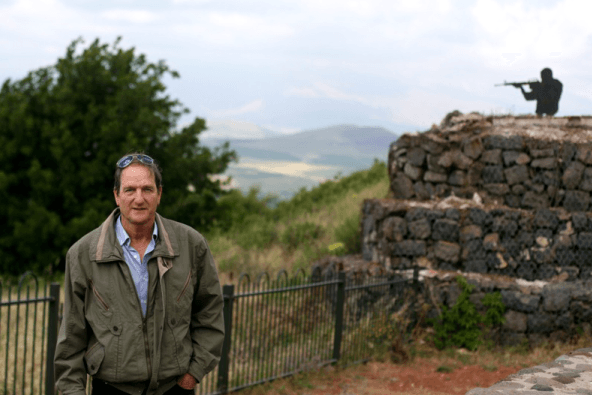Syria’s civil war ends long quiet in Israeli-controlled Golan Heights
Elisha Yelin, 66, has lived on a kibbutz in the Golan area since 1967. (Photo by Daniella Cheslow.)
Incoming rockets from Syria landed in the Israeli-occupied Golan Heights earlier this week.
A previously unknown group said the attack was meant to commemorate the anniversary of Nakba Day, when Palestinians mark the “catastrophe” of the founding of Israel is 1948. The rockets caused no damage, but they are another reminder to residents of the Israeli-controlled territory that decades of relative quiet along the frontier with Syria might now be coming to an end.
At a United Nations checkpoint near the Syrian town of al-Quneitra, a hulking white armored vehicle with “UN” written in big black letters passed from the Syrian to the Israeli side of the Golan Heights. The soldiers in camouflage uniforms and powder-blue helmets are part of the United Nations Disengagement Observer Force.
UNDOF has been patrolling the ceasefire line between Syrian and Israeli forces, known as the “area of separation,” since 1974. And its mission has largely been a success.
About 1,200 peacekeepers are deployed to prevent Syria and Israel from going to war yet again. But Syria’s own civil war is putting the UN operation in jeopardy.
For the second time, Syrian rebels last week kidnapped a group of four UN observers from the Philippines. They were soon released. But the government back in the Philippines said it plans to bring its contingent of peacekeepers home. That’s an ominous sign for some Israeli residents of the Golan Heights.
At the Israeli village of Alonei Habashan, they have been cleaning out the bomb shelters and updating emergency plans. Just in case. The community is home to a few hundred Israelis and it sits just a few hundred yards from Israel’s border fence along the Syrian frontier.
The fence was newly rebuilt in recent months. But that did not stop two stray Syrian rockets from landing inside the perimeter of the village.
“It’s extremely uncomfortable,” Israel Bar said.
He works as a manager at the village office of Alonei Habashan.
“We’ve had all these years of quiet here in the Golan and now, suddenly, there’s a lot to worry about,” he added.
Bar said the sounds of the fighting in Syria can be heard clearly and often from here. Residents are more careful about hiking in the area. They are sure to coordinate with the Israeli army when they go on long walks. They are also applying for permits to keep weapons in their homes.
Errant shells are one thing. But for many here, what is really alarming is the prospect of Syrian Army troops attacking Israelis.
This week, Israel Radio reported on a direct threat from Syria. The report included comments from Syria’s information minister, who said the Golan Heights — which Israel captured in the 1967 war — “still belong to Syria, from the sky above to the earth below.”
“Syria will do whatever it takes to liberate the territory from Israeli occupation,” the Syrian minister said.
That kind of rhetoric is nothing new. But there is a new reality. Israel is thought to have bombed Syria three times this year to stop weapons being transferred to Syria’s ally in Lebanon, Hezbollah. Syria’s President Bashar al-Assad has warned that another Israeli strike would bring retaliation. Many Israelis consider Assad to be the devil they know.
But the raging civil war brings uncertainty. Assad’s threats have to be taken seriously right now, said Inbal Alon. She’s an Israeli tourist from the center of the country, who was visiting the Golan Heights for the day with her husband, their two daughters and the family dog.
“Assad has a lot of power,” Alon said after lunch at a Druse Arab restaurant in the town of Mas’ade. “He could start a war with Israel and that could mean a lot of people getting killed.
“I don’t know what comes next in Syria,” she said. But at this point, “Assad is bad for Israel. I hope he falls.”
Still, “what will be in Syria” is a troublesome question for many Israelis living in the Golan Heights.
“Maybe it can be like in Gaza border, like terror situation,” said Elisha Yelin, a 66 year-old resident of a kibbutz near Mount Bental who has lived in the Golan for 45 years.
Yelin fought with the Israeli Army against Syrian troops during the 1973 war. He said people in this area might be in denial about how life could change along the ceasefire line.
Still, standing near the U.N. checkpoint and looking at the Israeli flag flying a few dozen yards from the Syrian flag on the other side, Yelin said, he respects it.
“I think this is the best situation,” Yellin said. “I have no problem with the Syrian flag, because this is a sign of government, of controlling, of something that you can trust.”
That flag, might be the flag of Israel’s enemy, Yelin said. But it’s also “a sign of stability.”
Yelin explained his real worry is about the UN peacekeeping force pulling out, Islamic extremist groups taking over the area along the old ceasefire line, and a failed state situation taking root right next door in Syria.
